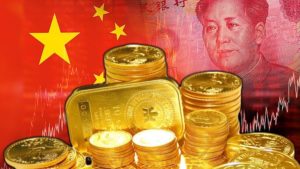China is making money moves that include a digital currency and doubling their gold buying quotas since 2019.
April 19, 2021
By: Bobby Casey, Managing Director GWP
In the media, these issues tend to stand alone as just tragedies without cause. But they aren’t. Because no one examines the data behind the issues, all the policies adopted around them are ineffective non-starters.
The Biden administration is calling for a withdrawal from Afghanistan. Good for him, but also, he has to undo the major propaganda campaign launched against Trump last year when he wanted to do the same thing.
When Trump announced he wanted to withdraw from Afghanistan, all the hawks from both sides of the spectrum, along with the media, descended upon him about Russia issuing bounties on American troops.
It’s since been discredited as a baseless claim, but the effort was enough to prevent Trump from taking credit. However, Biden has to clean up the frenzy and contend with other objections from hawks ranging from women’s rights to democracy in the country being undermined. As if that’s why the US was there in the first place.
Naturally this is getting a good amount of spin, when we aren’t hearing about guns and cops. Meanwhile, the border is getting buried in the headlines, and even further down the pile is what’s going on in China.
Well, the short version is: China is making money moves.
The still abridged, but slightly more detailed version is: they are stretching more into the gold space and jumping into crypto.
In 2017, this happened:
The Chinese have announced the launch of a gold-backed, yuan-denominated oil futures contract. The move potentially creates a way for oil exporters to circumvent US dollar denominated benchmarks by trading in yuan. The contracts will be priced in yuan, but convertible to gold.
This basically gave Iran a way of selling its oil without accepting payment in yuan, but still getting paid. China being the largest importer of oil, this was a monumental move both for China and oil exporters.
Just last week, China announced the launch of its own digital currency. Here’s the rub: it also comes with an expiration date.
Might as well make fresh cut flowers your currency: hurry up and use it before it dies and turns to trash!
That is actually the intention behind the state backed crypto-yuan. By setting an expiration date, it will urge people to spend it quicker with less incentive to save (read: hoard) it. Spending it for the sake of spending is not very productive.
It’s that Keynesian economic belief behind “stimulus” and welfare:
Obviously, China can impose this on its own people, but the likelihood of global adoption is unlikely. An expiration date cripples the monetary capacity of the currency out the gate. Why would anyone accept a currency in which its value will not be honored?
As for the gold, that’s another story. China has been building its gold stores for some time now. Some years were more aggressive than others, but in the past couple years, here’s how it broke down:
-
In 2019 China’s imports were at approximately $3.5 billion a month, or around 75 tonnes.
-
Since February 2020, China averaged imported gold worth around $600 million a month (roughly 10 tonnes)
-
Now, in 2021, around 150 tonnes of gold worth $8.5 billion at current prices is expected to ship
China is setting up the board, and the US is more than doing its inadvertent part to help in that effort. But there’s no hurry to undermine the dollar just yet.
Let’s look at the USD:
The global share of US-dollar-denominated exchange reserves dropped to 59.0% in the fourth quarter, according to the IMF’s COFER data released today. This matched the 25-year low of 1995. These foreign exchange reserves are Treasury securities, US corporate bonds, US mortgage-backed securities, US Commercial Mortgage Backed Securities, etc. held by foreign central banks.
Since 2014, the dollar’s share has dropped by seven full percentage points, from 66% to 59%, on average 1 percentage point per year. At this rate, the dollar’s share would fall below 50% over the next decade.
While the USD reserves are at 59%, China’s renminbi is at 2%. That’s one of the major reasons why they cannot undermine the dollar just yet. They carry a large amount of US debt ($1.063 trillion), and unless there’s an impending collapse where that debt is inevitably forfeit, China has no reason to accelerate the default process.
This isn’t a vilification of China. China is moving toward sound money no matter how they leverage it in the global market. The irony about all this is: while individual monetary activity is heavily regulated, but not so with global currencies. Each country has to answer to market forces for their policies.
Once again, China moves forward, while the US backslides. China has the backing of all the alienated countries sanctioned by the US. The US isn’t doing itself any favors by continuing down this path of inflationary policies, expanding welfare states, and growing military interventionism.
Click here to schedule a consultation on how you can protect your assets from overreaching governments, or here to become a member of our Insider program where you are eligible for free consultations, deep discounts on corporate and trust services, plus a wealth of information on internationalizing your business, wealth and life.


